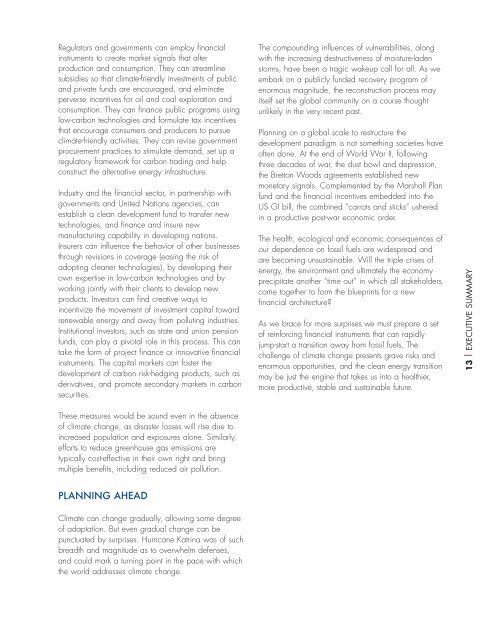Climate change futures: health, ecological and economic dimensions
Climate change futures: health, ecological and economic dimensions
Climate change futures: health, ecological and economic dimensions
You also want an ePaper? Increase the reach of your titles
YUMPU automatically turns print PDFs into web optimized ePapers that Google loves.
Regulators <strong>and</strong> governments can employ financial<br />
instruments to create market signals that alter<br />
production <strong>and</strong> consumption. They can streamline<br />
subsidies so that climate-friendly investments of public<br />
<strong>and</strong> private funds are encouraged, <strong>and</strong> eliminate<br />
perverse incentives for oil <strong>and</strong> coal exploration <strong>and</strong><br />
consumption. They can finance public programs using<br />
low-carbon technologies <strong>and</strong> formulate tax incentives<br />
that encourage consumers <strong>and</strong> producers to pursue<br />
climate-friendly activities. They can revise government<br />
procurement practices to stimulate dem<strong>and</strong>, set up a<br />
regulatory framework for carbon trading <strong>and</strong> help<br />
construct the alternative energy infrastructure.<br />
Industry <strong>and</strong> the financial sector, in partnership with<br />
governments <strong>and</strong> United Nations agencies, can<br />
establish a clean development fund to transfer new<br />
technologies, <strong>and</strong> finance <strong>and</strong> insure new<br />
manufacturing capability in developing nations.<br />
Insurers can influence the behavior of other businesses<br />
through revisions in coverage (easing the risk of<br />
adopting cleaner technologies), by developing their<br />
own expertise in low-carbon technologies <strong>and</strong> by<br />
working jointly with their clients to develop new<br />
products. Investors can find creative ways to<br />
incentivize the movement of investment capital toward<br />
renewable energy <strong>and</strong> away from polluting industries.<br />
Institutional investors, such as state <strong>and</strong> union pension<br />
funds, can play a pivotal role in this process. This can<br />
take the form of project finance or innovative financial<br />
instruments. The capital markets can foster the<br />
development of carbon risk-hedging products, such as<br />
derivatives, <strong>and</strong> promote secondary markets in carbon<br />
securities.<br />
The compounding influences of vulnerabilities, along<br />
with the increasing destructiveness of moisture-laden<br />
storms, have been a tragic wakeup call for all. As we<br />
embark on a publicly funded recovery program of<br />
enormous magnitude, the reconstruction process may<br />
itself set the global community on a course thought<br />
unlikely in the very recent past.<br />
Planning on a global scale to restructure the<br />
development paradigm is not something societies have<br />
often done. At the end of World War II, following<br />
three decades of war, the dust bowl <strong>and</strong> depression,<br />
the Bretton Woods agreements established new<br />
monetary signals. Complemented by the Marshall Plan<br />
fund <strong>and</strong> the financial incentives embedded into the<br />
US GI bill, the combined “carrots <strong>and</strong> sticks” ushered<br />
in a productive post-war <strong>economic</strong> order.<br />
The <strong>health</strong>, <strong>ecological</strong> <strong>and</strong> <strong>economic</strong> consequences of<br />
our dependence on fossil fuels are widespread <strong>and</strong><br />
are becoming unsustainable. Will the triple crises of<br />
energy, the environment <strong>and</strong> ultimately the economy<br />
precipitate another “time out” in which all stakeholders<br />
come together to form the blueprints for a new<br />
financial architecture?<br />
As we brace for more surprises we must prepare a set<br />
of reinforcing financial instruments that can rapidly<br />
jump-start a transition away from fossil fuels. The<br />
challenge of climate <strong>change</strong> presents grave risks <strong>and</strong><br />
enormous opportunities, <strong>and</strong> the clean energy transition<br />
may be just the engine that takes us into a <strong>health</strong>ier,<br />
more productive, stable <strong>and</strong> sustainable future.<br />
13 | EXECUTIVE SUMMARY<br />
These measures would be sound even in the absence<br />
of climate <strong>change</strong>, as disaster losses will rise due to<br />
increased population <strong>and</strong> exposures alone. Similarly,<br />
efforts to reduce greenhouse gas emissions are<br />
typically cost-effective in their own right <strong>and</strong> bring<br />
multiple benefits, including reduced air pollution.<br />
PLANNING AHEAD<br />
<strong>Climate</strong> can <strong>change</strong> gradually, allowing some degree<br />
of adaptation. But even gradual <strong>change</strong> can be<br />
punctuated by surprises. Hurricane Katrina was of such<br />
breadth <strong>and</strong> magnitude as to overwhelm defenses,<br />
<strong>and</strong> could mark a turning point in the pace with which<br />
the world addresses climate <strong>change</strong>.

















